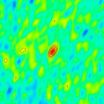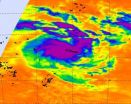(Press-News.org) Back in January, a new X-ray source flared and rapidly brightened in the Andromeda galaxy (M31), located 2.5 million light-years away. Classified as an ultraluminous X-ray source (ULX), the object is only the second ever seen in M31 and became the target of an intense observing campaign by orbiting X-ray telescopes -- including NASA's Swift -- and radio observatories on the ground. These efforts resulted in the first detection of radio-emitting jets from a stellar-mass black hole outside our own galaxy.
A ULX is thought to be a binary system containing a black hole that is rapidly accreting gas from its stellar companion. However, to account for the brilliant high-energy output, gas must be flowing into the black hole at a rate very near a theoretical maximum, a feeding frenzy that astronomers do not yet fully understand.
"There are four black hole binaries within our own galaxy that have been observed accreting at these extreme rates," said Matthew Middleton, an astronomer at the Anton Pannekoek Astronomical Institute in Amsterdam. "Gas and dust in our own galaxy interfere with our ability to probe how matter flows into ULXs, so our best glimpse of these processes comes from sources located out of the plane of our galaxy, such as those in M31."
As gas spirals toward a black hole, it becomes compressed and heated, eventually reaching temperatures where it emits X-rays. As the rate of matter ingested by the black hole increases, so does the X-ray brightness of the gas. At some point, the X-ray emission becomes so intense that it pushes back on the inflowing gas, theoretically capping any further increase in the black hole's accretion rate. Astronomers refer to this as the Eddington limit, after Sir Arthur Eddington, the British astrophysicist who first recognized a similar cutoff to the maximum luminosity of a star.
"Black-hole binaries in our galaxy that show accretion at the Eddington limit also exhibit powerful radio-emitting jets that move near the speed of light," Middleton said. Although astronomers know little about the physical nature of these jets, detecting them at all would confirm that the ULX is accreting at the limit and identify it as a stellar mass black hole.
The European Space Agency's XMM-Newton observatory first detected the ULX, dubbed XMMU J004243.6+412519 after its astronomical coordinates, on Jan. 15. Middleton and a large international team then began monitoring it at X-ray energies using XMM-Newton and NASA's Swift satellite and Chandra X-ray Observatory. The scientists conducted radio observations using the Karl G. Jansky Very Large Array (VLA) and the continent-spanning Very Long Baseline Array, both operated by the National Science Foundation in Socorro, N.M., and the Arcminute Microkelvin Imager Large Array located at the Mullard Radio Astronomy Observatory near Cambridge, England.
In a paper published online by the journal Nature on Wednesday, Dec. 12, the scientists reveal their successful detection of intense radio emission associated with a jet moving at more than 85 percent the speed of light. VLA data reveal that the radio emission was quite variable, in one instance decreasing by a factor of two in just half an hour.
"This tells us that the region producing radio waves is extremely small in size -- no farther across than the distance between Jupiter and the sun," explained team member James Miller-Jones, a research fellow at the Curtin University node of the International Centre for Radio Astronomy Research in Perth, Western Australia.
Black holes have been conclusively detected in two varieties: "lightweight" ones created by stars and containing up to a few dozen times the sun's mass, and supermassive "heavyweights" of millions to billions of solar masses found at the centers of most big galaxies. Astronomers have debated whether many ULXs represent hard-to-find "middleweight" versions, containing hundreds to thousands of solar masses.
"The discovery of jets tells us that this particular ULX is a typical stellar remnant about 10 times the mass of the sun, swallowing as much material as it possibly can," Middleton said. "We may well find jets in ULXs with similar X-ray properties in other nearby galaxies, which will help us better understand the nature of these incredible outflows."
Commenting on the findings on behalf of the Swift team, Stefan Immler at NASA's Goddard Space Flight Center in Greenbelt, Md., noted that it was almost exciting enough for astronomers to witness a new ULX so close to home, even if "close" is a few million light-years away. "But detecting the jets is a real triumph, one that will allow us to study the accretion process of these elusive black hole candidates in never-before-seen detail," he said.
INFORMATION:
Astronomers catch jet from binge-eating black hole
2012-12-13
ELSE PRESS RELEASES FROM THIS DATE:
Protein strongest just before death
2012-12-13
Researchers at Michigan State University have discovered a protein that does its best work with one foot in the grave.
The study, which appears in the current issue of the Journal of Biological Chemistry, focuses on the nontraditional lifestyle of Retinoblastoma tumor suppressor proteins, which could lead to new ways to treat cancer.
"Retinoblastoma proteins are unique in that they use controlled destruction to do their jobs in a timely but restrained fashion," said Liang Zhang, a lead author and MSU cell and molecular biology graduate student. "This is an unusual way ...
Experimental agent briefly eases depression rapidly in test
2012-12-13
A drug that works through the same brain mechanism as the fast-acting antidepressant ketamine briefly improved treatment-resistant patients' depression symptoms in minutes, with minimal untoward side effects, in a clinical trial conducted by the National Institutes of Health. The experimental agent, called AZD6765, acts through the brain's glutamate chemical messenger system.
Existing antidepressants available through prescription, which work through the brain's serotonin system, take a few weeks to work, imperiling severely depressed patients, who can be at high risk ...
Study reveals new factor that could limit the life of hybrid and electric car batteries
2012-12-13
COLUMBUS, Ohio – A new study of the batteries commonly used in hybrid and electric-only cars has revealed an unexpected factor that could limit the performance of batteries currently on the road.
Researchers led by Ohio State University engineers examined used car batteries and discovered that over time lithium accumulates beyond the battery electrodes – in the "current collector," a sheet of copper which facilitates electron transfer between the electrodes and the car's electrical system.
This knowledge could aid in improving design and performance of batteries, explained ...
NASA sees newborn Tropical Storm Evan causing trouble for American Samoa
2012-12-13
The date 12-12-12 may be numerically significant, but for the residents of American Samoa and Fiji in the South Pacific Ocean, it means a newborn tropical storm named Evan is causing problems. NASA's Aqua satellite and NOAA's GOES-15 satellite both captured imagery of the newborn storm's cloud cover.
Tropical Storm Evan caused regional warnings to be posted on Dec. 12. In American Samoa, a gale warning and storm watch are in effect for Tutuila, Aunuu, Manua and Swains Island.
The Atmospheric Infrared Sounder (AIRS) instrument aboard NASA's Aqua satellite captured an ...
Ceramic indoor cookstove use did not significantly lower child pneumonia risk in rural Kenya
2012-12-13
DEERFIELD, Il. (December 11, 2012)—Inexpensive, locally-produced ceramic cookstoves may produce less smoke than traditional indoor 3-stone firepits, but they don't significantly reduce indoor air pollution or the risk of pneumonia in young children, according to results from a small, year-long observational study by researchers working in rural Kenya.
The findings, published online today in the American Journal of Tropical Medicine and Hygiene, are the first to examine the health impacts of ceramic cookstoves that do not vent smoke to the outside of the house, said Robert ...
X-ray laser takes aim at cosmic mystery
2012-12-13
An international collaboration including researchers from Lawrence Livermore National Laboratory has refined a key process in understanding extreme plasmas such as those found in the sun, stars, at the rims of black holes and galaxy clusters.
In short, the team identified a new solution to an astrophysical phenomenon through a series of laser experiments.
In the new research, appearing in the Dec. 13 edition of the journal Nature, scientists looked at highly charged iron using the Linac Coherent Light Source (LCLS) free-electron laser. Highly charged iron produces ...
ASU researchers propose new way to look at the dawn of life
2012-12-13
TEMPE, Ariz. – One of the great mysteries of life is how it began. What physical process transformed a nonliving mix of chemicals into something as complex as a living cell?
For more than a century, scientists have struggled to reconstruct the key first steps on the road to life. Until recently, their focus has been trained on how the simple building blocks of life might have been synthesized on the early Earth, or perhaps in space. But because it happened so long ago, all chemical traces have long been obliterated, leaving plenty of scope for speculation and disagreement.
Now, ...
Got food allergies? Thanks to UCLA, you can test your meal on the spot using a cell phone
2012-12-13
Are you allergic to peanuts and worried there might be some in that cookie? Now you can find out using a rather unlikely source: your cell phone.
A team of researchers from the UCLA Henry Samueli School of Engineering and Applied Science has developed a lightweight device called the iTube, which attaches to a common cell phone to detect allergens in food samples. The iTube attachment uses the cell phone's built-in camera, along with an accompanying smart-phone application that runs a test with the same high level of sensitivity a laboratory would.
Food allergies are ...
HPV in older women may be due to reactivation of virus, not new infection
2012-12-13
[EMBARGOED FOR DEC. 13, 2012] A new study suggests that human papillomavirus (HPV) infection in women at or after menopause may represent an infection acquired years ago, and that HPV infections may exist below limits of detection after one to two years, similar to other viruses, such as varicella zoster, which can cause shingles. The study, published in The Journal of Infectious Diseases and available online, highlights the need for additional research to better understand HPV infections and the role of HPV persistence and reactivation, particularly in women of the baby ...
Discovered! The new species of Borneo's enigmatic primate with a toxic bite
2012-12-13
An international team of scientists studying the elusive nocturnal primate the slow loris in the jungles of Borneo have discovered an entirely new species. The team's analysis of the primate's distinctive facial fur markings, published in the American Journal of Primatology, reveals the existence of one entirely new species, while two of species, previously considered as possible sub-species, are being officially recognized as unique.
"Technological advances have improved our knowledge about the diversity of several nocturnal mammals," said Rachel Munds from the University ...



